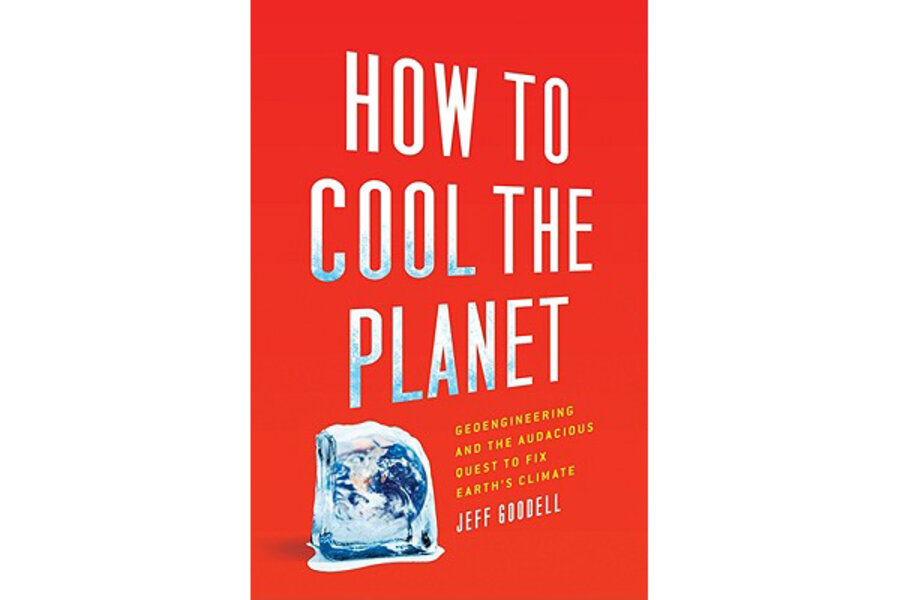How to Cool the Planet
Loading...
If you are a serious scholar of climate change, How To Cool the Planet is probably not for you. If you believe global warming is a hoax, it is definitely not for you. But if you are a reader like me, concerned about global warming and interested in a discussion of creative approaches to mitigating environmental disaster, this book is a perfect fit.
Author Jeff Goodell is a reporter, not a scientist. He is a contributing editor to Rolling Stone and a frequent contributor to The New York Times Magazine. Goodell’s skills as a writer and reporter make “How to Cool the Planet” blunt, incisive, easy to read, and a frankly funny treatment of geoengineering.
Geo-what? That’s what I said.
Geoengineering is “the deliberate large-scale intervention in the Earth’s climate system, in order to moderate global warming,” according to Britain’s Royal Society. And serious people are starting to talk about geoengineering seriously.
This science is still in its nascent stages, too immature for scientific journals and mainstream debate. The more far-out geo-engineering schemes include huge guns shooting heat-reflecting particles into the air, major mirror arrays in space, or huge ships sucking carbon dioxide right out of the atmosphere.
Like most of us, Goodell is skeptical of such ideas. Before we bet the bank on geoengineering, he argues, we must reduce our output of CO2, methane, and other particles that contribute to the greenhouse effect. There is simply no substitution for reasonable – or even radical – environmental conservation.
But, he points out, even if we were to cut our CO2 output to zero tomorrow, Earth would continue to warm for decades because CO2 stays in our atmosphere for a long time. Even a Herculean effort to reduce emissions will not solve the problem of climate change – a problem that threatens to disrupt weather patterns, destroy fragile ecosystems, and ultimately greatly reduce inhabitable land on Earth.
So in conjunction with emissions-reduction efforts, Goodell argues we must begin to look towards geoengineering and related sciences for ways to curb global warming.
Many scientists already are. Several companies have, over the past decade, begun to explore ocean fertilization – that is, stimulating plankton blooms that suck CO2 at amazing rates (by some estimates, the cost of stimulating a plankton bloom is one hundred times less than planting trees to remove the same amount of CO2).
Stephen Salter at the University of Edinburgh in Scotland has another idea of how to cool the earth: cloud whitening. He believes we can spray clouds with seawater to reduce the size of their individual water droplets, thereby increasing their brightness and solar reflectivity.
In a chapter titled “Doping the Stratosphere,” Goodell tells how other scientists suggest we can create volcano-like devices to spray the air with a sulfur gas or inert metallic substances such as aluminum.
Of course, this stuff gets complicated in a hurry. Scientific questions remain large. “There are an enormous number of complexities here, an enormous number of relationships, that we’re just beginning to understand,” says Stephen Scheider, a Stanford University climate scientist and geoengineering critic, in the book.
Goodell agrees. He also discusses briefly the political, economic, and social questions surrounding geoengineering. For example, what country, company, or international organization has the authority to change the atmosphere in a way that affects everybody? Who pays? What if some folks don’t want their atmosphere changed?
But, argues Goodsell, geoengineering – with its potential and its problems – is here to stay. After all, he says, “it might be prudent at least to begin to research these options in earnest – if only so that we can discover what doesn’t work now before we urgently need a fix.”
Goodell’s book is a quick, enjoyable read through a complex, timely topic. And after you read it, you’ll never look at the sky or the ocean – or Earth, really – in quite the same way again.
Will Buchanan is an intern at the Monitor.






